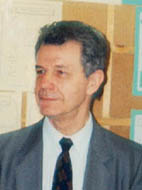
Professor, Doctor of Science, Ph.D.,
The Founder of the Laboratory of Nitrogenous Compounds
 |
Leonid B.Volodarsky Professor, Doctor of Science, Ph.D., The Founder of the Laboratory of Nitrogenous Compounds |
TITLES, EDUCATION:
1994 Russian Federation State Prize Winner in Science
1989 Chairman of IUPAC International Conference on Nitroxide Radicals, Novosibirsk, USSR
1976 Full Professor of the chair Organic Chemistry, Novosibirsk State University
1972 Doctor of Chemical Science (Doctor Nauk), Institute of Organic Chemistry, Academy of Sciences, Novosibirsk
1963 Ph.D.in Chemistry, Institute of Organic Chemistry, NovosibirskEXPERIENCE, EMPLOYMENT:
1980-1998 Head of Laboratory of Nitrogenous Compounds, Institute of Organic Chemistry, Academy of Sciences, Novosibirsk
1970-1995 Lectures and seminars in general course "Organic Chemistry", Novosibirsk State University
1991 Aug. XIII International Congress of Heterocyclic Chemistry, OR, USA, Plenary lecture "Imidazoline Nitroxides. Synthesis and Applications"
1989 Sep. IUPAC International Conference on Nitroxide Radicals, Novosibirsk, USSR. Plenary lecture "Advances in the Chemistry of Stable Nitroxides"
1970-1976 Associate Professor of the chair Organic Chemistry, Novosibirsk State University
1962-1980 Senior Scientific Fellow of Laboratory of Organic Reaction Mechanisms, Institute of Organic Chemistry, Academy of Sciences, Novosibirsk
AREAS OF COMPETENCE:
SCIENTIFIC SCHOOL, PUBLICATIONS:
18 Ph.D.Theses and 4 Doctor of Sciences Theses in the frame of this laboratory were carried out. The list of publications includes more than 340 papers, 10 reviews, more than 70 licenses and patents, 3 monographs in USA and 1 in Russia
Monographs:
PRINCIPAL RESEARCH INTERESTS:
Organic hydroxylamine derivatives attract an attention of the researchers as metabolites of oxidation processes and initial compounds for the synthesis of nitrones, nitroxide radicals and heterocyclic N-oxides. Additional oxo-,hydroxyimino-, hydroxy- or other group in adjacent position provides the possibility of producing various heterocycles. 1,2-Hydroxylaminoketones and hydroxylaminooximes possess a number of properties related to presence of two reactive groups and were used to produce 4-, 5-, 6- and 8-membered heterocycles. Their capability to react with aldehydes and ketones affords cyclic hydroxylamines, oxidation of which easily gives stable nitroxide radicals (SNR). The SNR have found wide applications as spin labels, probes and traps in molecular biology and medicine, as ligands for materials with ferromagnetic properties, as inhibitors in polymer processing, as initiators for "living" radical polymerization etc. The main investigation directions of laboratory therefore:
RESEARCH ACTIVITY (1993-1998):
To provide the expansion of a set of basic acyclic compounds derivatives a procedures for the synthesis of bishydroxylamines, hydroxylaminoamines and hydroxylaminoalcohols have been developed. On the basis of bishydroxylamines it was realized the synthesis of 1,2,3-triazole-2-oxides and 2-hydroxytriazoles representing unavailable derivatives with nitrogen-oxygen bond in position 2. With the same goal of the expansion the synthesis of new 1,2-hydroxylaminooximes containing pyridine or thiophene cycle conjugated with oxime group has been carried out. Basing on these compounds open and cyclic nitrones and nitroxide radicals were synthesized. Recently ammonium acetate catalytic effect on 1,2-hydroxylaminooximes, 1,2-hydroxylaminoketones and 1,2-hydroxylaminoalcohols condensation with ketones was observed which provided a large variety of new hindered derivatives of 1-hydroxy-3-imidazoline and 1-hydroxyoxazolidine. It was also shown that a stability of nitroxide radical can be provided not only by alkyl groups at alpha carbon atoms, but also by aryl-, and alkoxy-groups and even by hydrogen atom if hindered rotation maintains C-H bond in the nodal plane thus inhibiting the disproportionation.
In the last decade the use of alpha-diketone monooximes (isonitrosoketones or tautomeric O-nitrosophenols) turned to be promising for the synthesis of heterocyclic compounds. Thus, pyrrolidine N-oxide derivatives readily resulted in from an interaction of isonitrosoketones with enamines or with ketones and amines. These derivatives were demonstrated to be of interest as synthetic equivalents od 1,4-dicarbonyl compounds and therefore convenient synthons in the synthesis of pyrroles, indoles, pyridazines, cynnolines etc.
Last updated: February 17, 2000